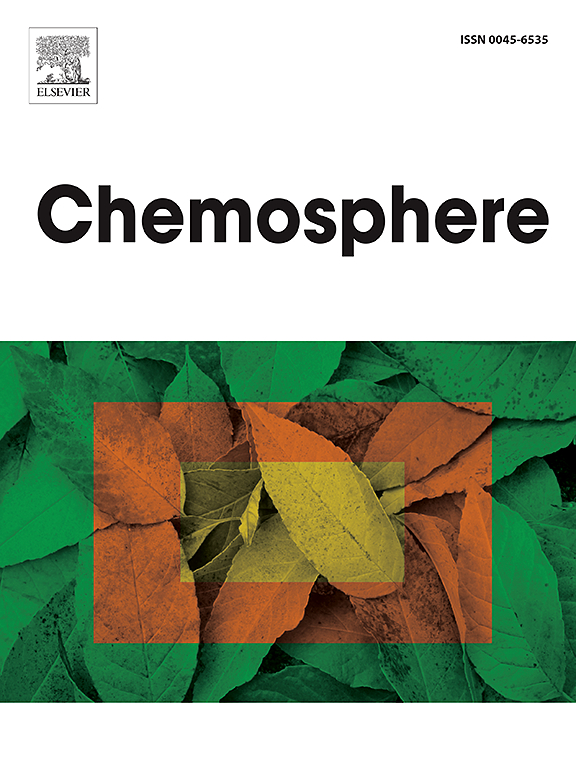Mo2Ti2AlC3 MXene前驱体修饰电极上灵敏选择性安培法测定全氟辛磺酸。
IF 8.1
2区 环境科学与生态学
Q1 ENVIRONMENTAL SCIENCES
引用次数: 0
摘要
各种商业和工业产品广泛使用剧毒的八碳链全氟辛烷磺酸(PFOS),对生物体的健康构成重大威胁。本研究采用Mo2Ti2AlC3 MAX相制备碳糊电极(CPE),实现了PFOS的电化学检测。合成了Mo2Ti2AlC3,并将其直接用于CPE的构建。利用循环伏安法(CV)、电化学阻抗谱法(EIS)、差分脉冲伏安法(DPV)和安培滴定法等电化学技术对所制备传感器的电化学性能进行了测试。该电化学传感器具有0.001 ~ 0.09 μM和1.1 ~ 62.6 μM的线性范围,检出限为0.04 nM。该传感器具有较高的灵敏度,测量值为145.1 μA μM-1 cm-2,工作电位为0.3 V时,响应时间为5秒。此外,该传感器对典型的干扰化学物质具有出色的抵抗力。在实际样品中进一步验证了该传感器的适用性和可靠性,回收率为92.6 ~ 107.7%,相对标准偏差(RSD)值为1.8% ~ 3.7%。基于Mo2Ti2AlC3 MAX相的电化学传感器具有简单、快速、灵敏和经济的优点,是一种很有前途的环境水和土壤样品中全氟辛烷磺酸的定量方法。本文章由计算机程序翻译,如有差异,请以英文原文为准。

A sensitive and selective amperometric determination of perfluorooctanesulfonic acid on Mo2Ti2AlC3 MXene precursor-modified electrode
Various commercial and industrial products widely use highly toxic eight-carbon-chain perfluorooctanesulfonate (PFOS), posing a significant threat to the health of living organisms. In this study, the electrochemical detection of PFOS was achieved by developing a carbon paste electrode (CPE) using the Mo2Ti2AlC3 MAX phase. Mo2Ti2AlC3 was synthesized and directly used to construct the CPE. The electrochemical performance of the prepared sensor was tested using various electrochemical techniques, such as cyclic voltammetry (CV), electrochemical impedance spectroscopy (EIS), differential pulse voltammetry (DPV), and amperometric titration. The developed electrochemical sensor exhibited two linear ranges from 0.001 to 0.09 μM and from 1.1 to 62.6 μM, with a detection limit of 0.04 nM. The sensor demonstrated high sensitivity, measuring 145.1 μA μM−1 cm−2, and a response time of 5 s for PFOS quantification at a working potential of 0.3 V. Additionally, the sensor demonstrated outstanding resistance to typical interfering chemicals. The applicability and reliability of the developed sensor for PFOS determination were further tested in real samples, yielding recoveries in the range of 92.6–108.2%, with relative standard deviation (RSD) values between 1.8% and 3.7%. The Mo2Ti2AlC3 MAX phase-based electrochemical sensor is simple, rapid, sensitive, and cost-effective, making it a promising approach for the quantification of PFOS in environmental water and soil samples.
求助全文
通过发布文献求助,成功后即可免费获取论文全文。
去求助
来源期刊

Chemosphere
环境科学-环境科学
CiteScore
15.80
自引率
8.00%
发文量
4975
审稿时长
3.4 months
期刊介绍:
Chemosphere, being an international multidisciplinary journal, is dedicated to publishing original communications and review articles on chemicals in the environment. The scope covers a wide range of topics, including the identification, quantification, behavior, fate, toxicology, treatment, and remediation of chemicals in the bio-, hydro-, litho-, and atmosphere, ensuring the broad dissemination of research in this field.
 求助内容:
求助内容: 应助结果提醒方式:
应助结果提醒方式:


